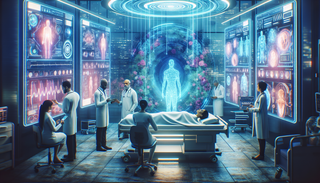
The stethoscope's new partner: an ensemble of GPUs
When René Laennec invented the stethoscope in 1816, he gave clinicians super-hearing. Two centuries later, clinicians are gaining super-vision. Deep-learning models now read X-rays, MRIs and CT scans at accuracy levels that consistently rival—or in narrow tasks, surpass—human radiologists. A 2024 multi-center trial, for example, showed an AI mammography reader cutting false negatives by 7 % without increasing recalls. Rather than replacing doctors, these systems act like a second set of expert eyes, catching subtleties the 12-hour-shift human brain can miss.
Behind the scenes, convolutional neural networks trained on millions of annotated images are doing the heavy lifting. Vendors such as Viz.ai and Aidoc stream urgent scans to cloud GPUs, triaging stroke and pulmonary embolism cases in minutes. Clinicians receive push notifications on their phones the moment an intracranial bleed is flagged, shrinking door-to-needle time—and, for many patients, long-term disability.
From one-size-fits-all to N-of-1 medicine
Precision medicine once meant genotyping a tumor to pick a chemotherapy drug. AI expands that idea beyond genetics, ingesting electronic health records, wearable data, lifestyle factors and real-time vitals to build a continuously updating risk model for every individual.
At Mount Sinai's Icahn School of Medicine, the "Digital Twin" project trains transformer architectures on billions of data points to simulate disease trajectories. Feed it your latest lab work and it estimates the probability you'll develop type-2 diabetes within five years—and which micro-interventions will bend that curve. Early pilots report 20 % higher adherence to lifestyle changes when patients see their personal 'future self' projection.
Meanwhile, language-model-powered clinical decision support is tackling polypharmacy. Instead of sifting through long PDF guidelines, physicians can query a system that's embedded the full corpus of medical literature. Ask, "What's the safest anticoagulant for a 72-year-old Asian female with AFib and stage-3 CKD?" and receive an evidence-ranked answer in seconds, complete with citations.
Accelerating the drug pipeline
Bringing a new molecule to market averages US$2.6 billion and 10-plus years. AI promises to lop years off the pre-clinical stage. Generative models like AlphaFold have already cracked protein folding; the next leap is generative chemistry. Start-ups such as Insilico Medicine generate virtual compound libraries, score them for binding affinity, toxicity and synthesizability, and feed the top hits directly to wet-lab robots. In 2024 Insilico's fibrosis candidate moved from in-silico design to Phase 1 humans in 30 months—a record in the field.
Regulators are taking notice. The FDA's new "Algorithmic Drug Design" guidance, released May 2025, outlines a fast-track review pathway that accepts AI-derived structure-activity data as partial evidence, provided the underlying training sets are made auditable. Transparency, long the Achilles' heel of deep learning, is becoming a regulatory mandate rather than a nice-to-have.
Trust, bias and the quest for explainability
AI's potential is matched by the risk of silent failure. A 2023 study found that a sepsis prediction model trained mostly on urban tertiary hospitals under-performed in rural settings, missing 40 % of cases in Native American populations. The culprit was a subtle bias in baseline vitals. Techniques like SHAP value decompositions and counterfactual explanations are helping developers surface such blind spots before deployment.
Hospitals, for their part, are assembling AI oversight committees that blend clinicians, data scientists and ethicists. These boards audit algorithms for bias drift and monitor real-world performance post-launch, mirroring the pharmacovigilance that surrounds new drugs.
The economics of an AI-augmented ward
Skeptics argue that flashier algorithms don't automatically translate into healthier bottom lines. Yet early ROI data are promising. The U.K.'s National Health Service reports that AI sepsis alerts cut ICU length of stay by 1.3 days on average, saving £4,200 per admission. In the U.S., insurer Humana estimates that predictive analytics for readmission risk are reducing penalties under Medicare's HRRP program by 8 % year-on-year.
These cost offsets matter because the hardware bill is non-trivial: a single 8-GPU inference server can cost US$150k. Cloud inference, once cheaper, is becoming pricier as vendors introduce "AI tax" premiums. Forward-looking CIOs are experimenting with hybrid models—edge TPUs in the radiology suite for latency-sensitive tasks, cloud clusters for big-batch research training.
What comes next
Looking five years out, three converging trends stand out:
- Multi-modal models: The next generation will fuse images, genomics, physician notes and real-time sensor data into a single graph, enabling earlier and more holistic interventions.
- Federated learning: Privacy laws make it hard to centralize patient data. Federated frameworks train models across hospitals without sharing raw records, preserving confidentiality while enlarging sample diversity.
- Ambient clinical interfaces: Instead of clicking through EHR menus, clinicians will dictate "Order a CBC and schedule a cardio consult," while an LLM agent auto-fills orders and insurance codes.
If these trends pan out, the boundary between "AI" and "routine clinical software" will blur. Much like electricity, machine intelligence will recede into the walls—indispensable yet invisible.
Bottom line
AI in healthcare has vaulted from pilot projects to production systems that touch millions of patients. The technology's ultimate success, however, hinges less on algorithmic cleverness and more on human factors: unbiased datasets, transparent validation and workflows that respect clinician time. Get those right, and the stethoscope's 21st-century upgrade could become the default tool for global health equity.
Sources
- Financial Times – "The doctors pioneering the use of AI to improve outcomes for patients"
- arXiv preprint – "A Survey of Remote Patient Monitoring using Wearable Sensors and AI"